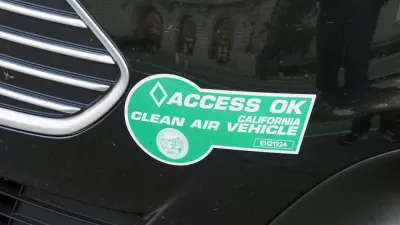Neighborhood electric vehicles may become more popular in California's second most populous county thanks to legislation signed by Gov. Jerry Brown. The small zero-emission vehicles are prohibited from crossing streets with speed limits above 35 mph.

A July 2011 feature post warned that "dismissing neighborhood electric vehicles (NEVs) is a mistake," and that "planners can use NEV planning to make more walkable urban centers." Thanks to a bill by Senator Patricia Bates (R-Laguna Niguel), we may see if these low-speed, zero-emission vehicles can offer environmentally-friendly mobility options to residents beyond those living in master-planned retirement communities with golf courses.
The bill "[d]efines a neighborhood electric vehicle, also known as a low-speed vehicle, as a motor vehicle that is four-wheeled, can attain a speed of at least 20 but not more than 25 miles per hour, and has a gross vehicle weight rating of less than 3,000 pounds."
"Driving around in a neighborhood electric vehicle is a good way to run errands in your neighborhood without having to drive in your car," states Bates in her press release thanking Gov Jerry Brown (D) for signing Senate Bill 1151 – Neighborhood electric vehicles: County of San Diego on Sept. 19. She touted the reduction of greenhouse gas emissions** offered by these lower-priced zero-emission vehicles, though a regional plan envisions them as shared vehicles.
Transportation plan needed
Sponsored by the San Diego Association of Governments (SANDAG), SB 1151 allows the county and any of its 18 cities to adopt a Neighborhood Electric Vehicle transportation plan by January 1, 2029, in consultation with SANDAG "and any agency having traffic law enforcement responsibilities in an entity included in the plan area," according to the California Association of Councils of Governments. Within two years of adoption, a report on the plan would have to be submitted to the state legislature.
"The new law allows a city to develop a plan that will provide for safe crossing of the arterials, making a much larger territory accessible via NEV," explained David Grubb, transportation chair of the San Diego Chapter of the Sierra Club, which supported the bill, in an email.
One example is the city of Coronado, where NEV's are very popular. The main street all the way through town cannot be crossed by a NEV, blocking most residents from driving their NEV to the grocery store. Coronado pushed hard to get this legislation, and will soon have a plan that makes the whole city NEV-accessible.
SANDAG notes that the 2019-2050 Regional Plan known as San Diego Forward, "envisions the expansion of publicly-shared NEVs as a way to provide a clean, economical, and convenient transportation alternative for neighborhood trips or connecting to transit."
Much potential, but a poor legislative track record of implementation
SB 1151 has had many predecessors for different regions, but only one jurisdiction has actually had a NEV transportation plan approved by the legislature, according to the Aug. 31 legislative analysis:
Since 2004, the Legislature has passed many similar bills with widespread bipartisan support authorizing NEV transportation plans to be adopted in jurisdictions throughout California, including the cities of Fresno, Jackson, Lincoln, Rocklin, and Sutter Creek, the counties of Amador and Riverside, and a planned community in Orange County. However, only the City of Lincoln has implemented a plan. The City of Lincoln reported that its plan has “generally been successful” and recommended state-wide authorization.
The award-winning plan [pdf] for the fast-growing small city in Placer County was the topic of a February 2007 Western City article, "Lincoln Puts Neighborhood Electric Vehicles on the Road."
A more recent Neighborhood Electric Vehicle (NEV) Plan [pdf] was prepared for the Coachella Valley Association of Governments (Riverside County) in March 2015. Although there doesn't appear to be corresponding state legislation for the plan, it points to other NEV plans:
A number of local cities and counties in California (Lincoln, Rocklin, Western Riverside County, Rancho Mission Viejo, Coronado, and Playa Vista), have developed NEV Plans with various goals such as reducing reliance on gasoline, reducing vehicle emissions, reducing roadway wear and tear, and creating more sustainable communities.
NEV posts in Planetizen
- Mainstreaming the Golf Cart, October 12, 2015. [Read perceptive reader comment].
- Golf Carts: California's Latest Transit Trend, August 19, 2002
FULL STORY: Gov. Brown Signs Bill Granting San Diego County Neighborhood Electric Vehicle Plan

Study: Maui’s Plan to Convert Vacation Rentals to Long-Term Housing Could Cause Nearly $1 Billion Economic Loss
The plan would reduce visitor accommodation by 25,% resulting in 1,900 jobs lost.

North Texas Transit Leaders Tout Benefits of TOD for Growing Region
At a summit focused on transit-oriented development, policymakers discussed how North Texas’ expanded light rail system can serve as a tool for economic growth.

Using Old Oil and Gas Wells for Green Energy Storage
Penn State researchers have found that repurposing abandoned oil and gas wells for geothermal-assisted compressed-air energy storage can boost efficiency, reduce environmental risks, and support clean energy and job transitions.

Opinion: DC Encampment Sweeps Hide, but Don’t Solve, Homelessness
President Trump recently ordered the clearing of encampments built by unhoused people on federal land in Washington, D.C.

Santa Barbara Could Build Housing on County Land
County supervisors moved forward a proposal to build workforce housing on two county-owned parcels.

San Mateo Formally Opposes Freeway Project
The city council will send a letter to Caltrans urging the agency to reconsider a plan to expand the 101 through the city of San Mateo.
Urban Design for Planners 1: Software Tools
This six-course series explores essential urban design concepts using open source software and equips planners with the tools they need to participate fully in the urban design process.
Planning for Universal Design
Learn the tools for implementing Universal Design in planning regulations.
Ascent Environmental
Borough of Carlisle
Institute for Housing and Urban Development Studies (IHS)
City of Grandview
Harvard GSD Executive Education
Toledo-Lucas County Plan Commissions
Salt Lake City
NYU Wagner Graduate School of Public Service





























